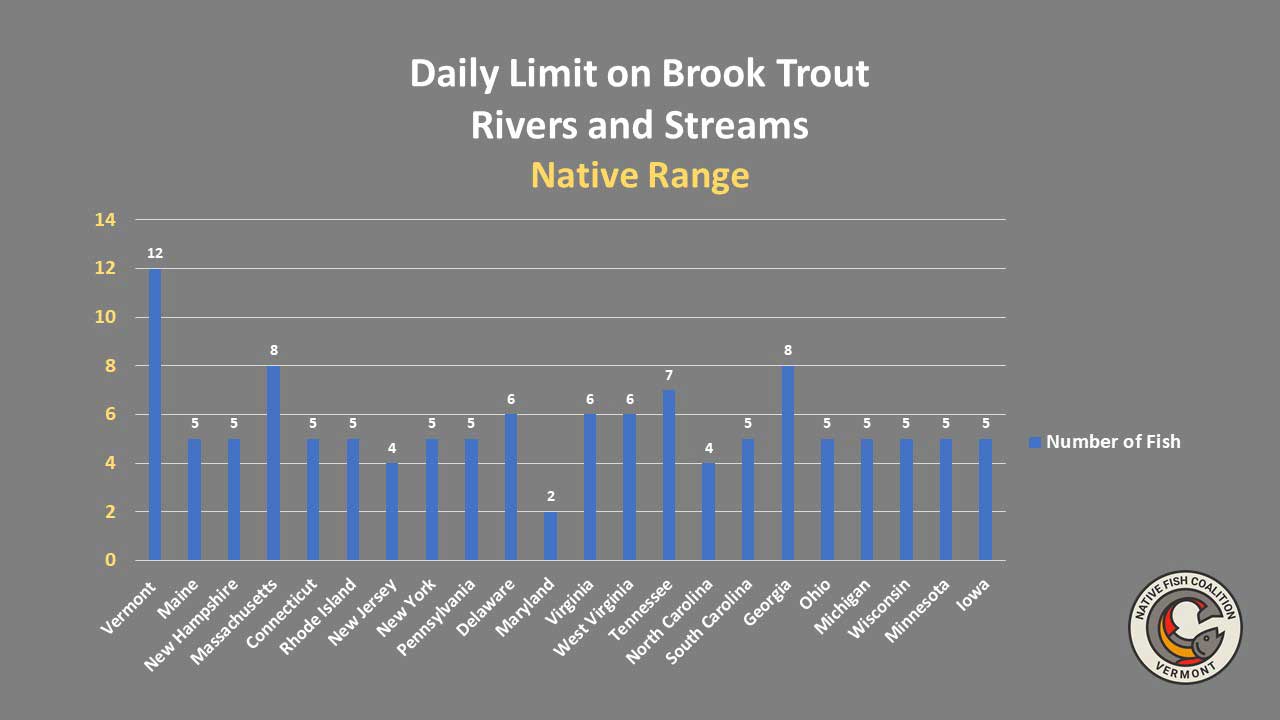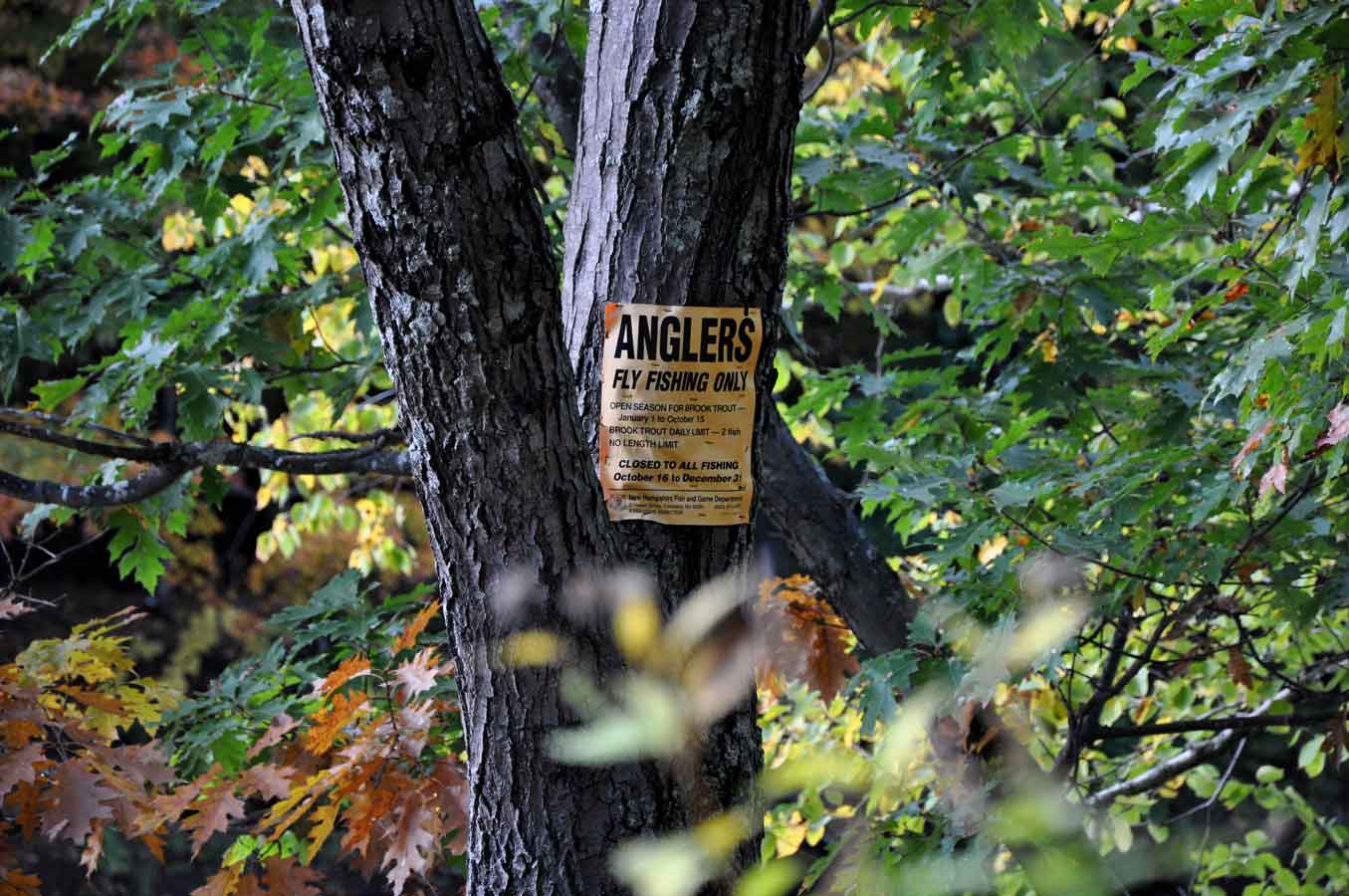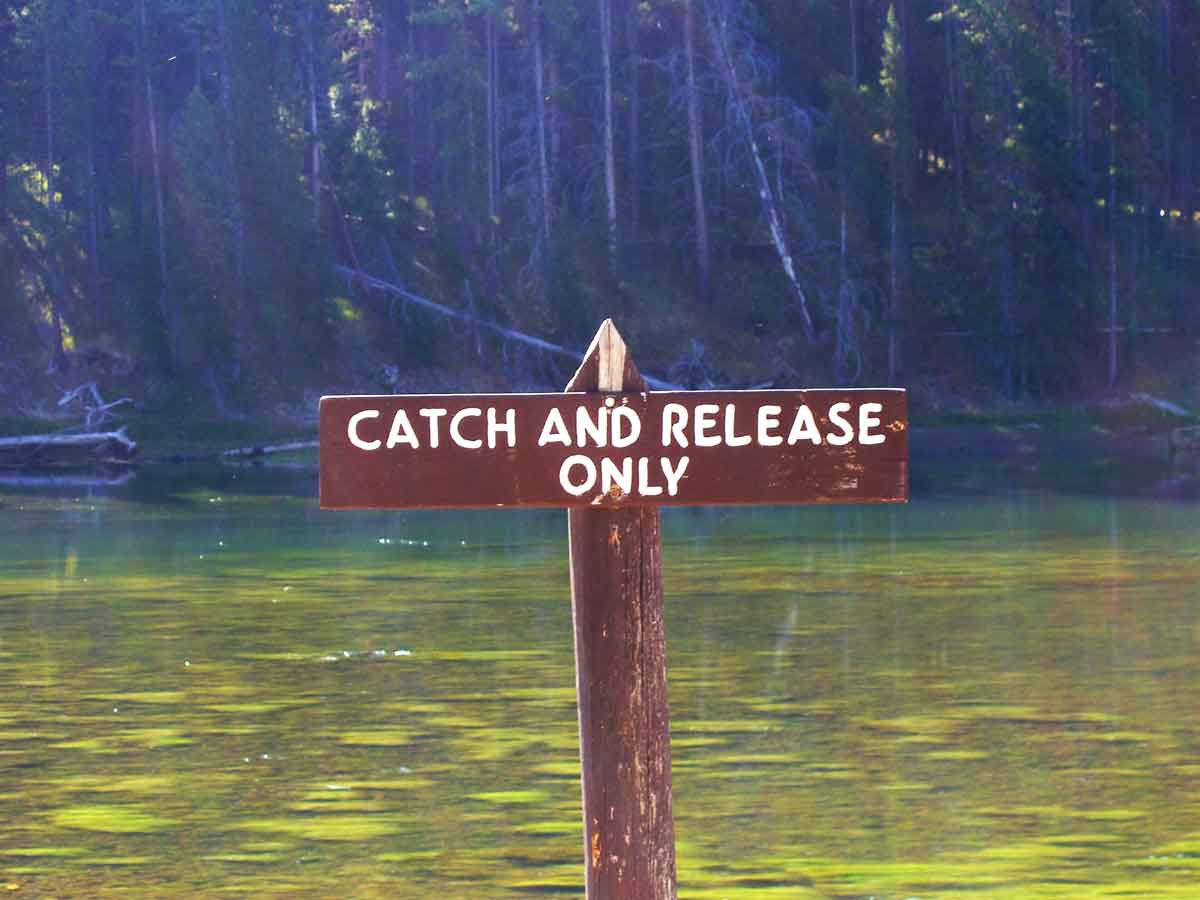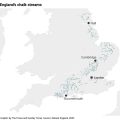Daily Bag Limits on Trout: What the Numbers Tell Us

Note the radical differences in regard to the daily bag limits on brook trout in rivers and streams within their native range. (Native Fish Coalition)
Editor’s Note: This is the third article in our series on fly fishing conservation. This series appears with the support of Swift Fly Fishing, makers of Epic Fly Rods.
When it comes to trout fishing, the standard daily harvest or “bag limits” across the country are all over the map, and in many cases, not what you would expect them to be, or in fact what they should be. This is because they are often dictated by social desires, and public pressure, rather than ecological impact. And at best they’re based more on conservation, not preservation—and in some cases, neither.
In 2017, the Michigan Natural Resources Commission doubled the daily bag limit on brook trout in 33 streams in the Upper Peninsula. The limit leaped from 5 fish to 10 fish due to pressure from local anglers who want to eat trout. It was reversed in 2018 due to a clerical error, reinstated in 2019, and reversed again in 2020 due to lawsuits, hardly what could be called science.
Harvest limits are set based on the assumption that not everyone will keep their limit, or at least not every time they go, and some won’t keep any fish at all. It also assumes not everyone fishes every day, and that waters are not always fishable. While these are reasonable assumptions, they are exactly that, assumptions, and as wrong as they are right. One group of determined anglers can change the game by acting outside the assumed norms.
While daily bag limits often, but not always, look reasonable at the individual level, the real issue is the aggregate impact of the masses. Consider a 5-fish daily limit that is filled just 50 times in a season for a total of 250 fish harvested. This could have a significant impact on a small pond or stream, especially in places like New England where waters are relatively infertile.
To be clear, what I am talking about here is what is often referred to as the “general law.” Many waters have special regulations applied to them. But again, to be fair, in most states the general law is in effect far more frequently than special regulations. And in some types of waters, small streams for example, they are the rule.
“In 2017 — after persistent lobbying by Upper Peninsula anglers and sports groups — a state commission doubled the daily catch limit for brook trout in 33 streams that stretch more than a thousand miles throughout the U.P., from five fish per day to 10.” – Bridge Magazine
Good Science?
Harvest is not a “management tool,” as some fisheries biologists and anglers like to claim, at least not from a biological standpoint. It is a concession made for social reasons. Fisheries do not need harvest to remain healthy, as evidenced by early fishing pictures that show fish that are much larger than what we find in those same waters today. An exception is high bag limits associated with nonnative fish that encourage removal to benefit native fish.
Contrary to what some fisheries biologists say, angler harvest is not always “compensatory mortality” or fish that were going to die anyway – at least literally. It can be “additive” (in addition to) to at least some degree, and in some cases a high degree. A couple of years ago we encountered a large group on a small remote stream. Based on the size of the group and the bulging bread bags, I estimated they had taken over 40 fish from less than a mile of stream. While it will likely eventually recover, it hasn’t fished the same since.
Fisheries managers sometimes promote harvest as a way to increase “size quality,” by decreasing what they refer to as “stockpiling.” The implication is that there are too many fish, or too many mouths to feed, and reducing their numbers will allow the remaining fish to get bigger. While this form of population manipulation, or husbandry, works in some cases, it fails to deliver on its promise in many, maybe most, cases, as it’s just not that simple.
“While you can harvest your way into trouble, you can rarely harvest your way out of it” -Bob Mallard
A Complete Lack of Consistency
Within the 22 states where brook trout are native, the daily bag limit on rivers and streams varies from 2- to 12-fish, for an average of roughly 5.6 fish, and a 10-fish top-to-bottom variance. What could possibly be so biologically different between these states to justify such a discrepancy? The answer is nothing, it’s purely social and ideological…
The highest daily limit on rivers and streams within brook trout range is found in Vermont, and by far. In fact, at 12-fish, Vermont is 33% higher than the next two highest states — Massachusetts and Georgia — and twice as high, or more, than 18 other states. Amazingly, neighboring New Hampshire, a state very ecologically and socially similar to Vermont, has a daily limit of just 5-fish, as does nearby Maine. Can anything truly justify this?
The lowest daily limit on brook trout in rivers and streams is Maryland at 2-fish. New Jersey and North Carolina are the second lowest at 4-fish. Twelve states have 5-fish limits, three 6-fish, one 7-fish, and two 8-fish. And the only discernible regional consistency is the Midwest, where all five states have a 5-fish daily limit, drawing into question the regional inconsistencies found elsewhere.
Lakes and Ponds Versus Rivers and Streams
Trout are undeniably a fly-fishing-centric species, as evidenced by the associated literature, art, media, advocacy machine, and outreach arm. And fly fishing is a stream-centric activity, with stillwaters taking an absolute backseat to moving water. A quick look at any trout- or fly-centric publication will confirm this, a river stills runs through it.
Most eastern states treat their lake and pond trout better than their river and stream fish when it comes to bag limits. For example, most of Maine’s special regulations, referred to as S-Codes, that reduce the bag limit, usually 2-fish with some sort of slot limit, are applied exclusively to lakes and ponds. And far more lakes and ponds have reduced bag limits than rivers and streams, in fact, it’s not even close.
In Massachusetts, while the daily limit on trout is just 3 fish in lakes and ponds and 29 select “major rivers,” it is 8-fish, or more than 2.5 time higher, on all other rivers and streams. In Vermont, the aggregate limit on “trout” (brook, brown, and rainbow) in lakes and ponds is 6 fish, while on its rivers and streams , it’s a whopping, and highest in the east, 12-fish.
Western states usually treat rivers and streams better, or the same, as lakes and ponds when it comes to bag limits. Wyoming has a 3-fish limit on “trout” (all species) in rivers and streams, and a 6-fish limit on lakes and ponds. Is this because many of these waters are stocked, the stillwater angler is more likely to harvest fish, or moving water is seen as more economically valuable?
Stocked Fish Versus Wild Fish
Throughout the East and Midwest, stocked trout are often better protected than wild trout. Is this because they are easier to exploit, more pressured, or that state fisheries managers and biologists see more value in them as they have to pay to raise them?
In Maine, brook trout in lakes and ponds in the mostly stocked South Zone are subject to a 2-fish daily limit. In the North Zone, home to most of the state’s wild brook trout the limit is 5 fish. While the limit on brook trout in rivers and streams, many of which are wild, is 5-fish, the daily limit on browns and rainbows, most of which are stocked, is just 2-fish.
In Vermont, the aggregate limit on “trout” (brook, brown, and rainbow) on rivers and streams, home to most of the state’s wild trout, is 12-fish, while the limit on lakes and ponds which are mostly stocked is just 6-fish. While all 12 fish on rivers and streams can be brook trout, many of which are wild, only 6 can be browns or rainbows which are more likely to be stocked than wild.
“Most of Vermont’s brook trout lake and pond fisheries are supported entirely by stocking… A few ponds are not stocked at all.” -Vermont Fish & Wildlife
Most wild brook trout streams in New Hampshire are subject to a 5-fish daily limit. Conversely, many stocked waters have reduced bag limits. For example, sections of the heavily stocked Saco and Ellis Rivers have 2-fish limits, while most of the Dead Diamond River, the finest wild brook trout river in the state, has a 5-fish limit. A quick analysis of reduced creel regulations associated with rivers and streams showed that roughly 75% involved stocked waters. The situation regarding lakes and ponds is worse, with over 85% of reduced bag limits applied to stocked waters.
A similar situation exists in neighboring Massachusetts. As noted above, the daily limit on trout in lakes and ponds and “major rivers” is 3 fish. Streams, where most wild trout are found, are subjected to an 8-fish limit, second only to Vermont’s staggering 12-fish limit. Virtually all lakes and ponds in Massachusetts are stocked, as are 23 of the 29 so-designated major rivers.

While Massachusetts’s heavily stocked Swift River is catch-and-release, most wild native brook trout streams are subject to an 8-fish daily limit. Dana Mallard photo
Native Fish Versus Nonnative Fish
Throughout the East and Midwest, nonnative trout are often better protected than native trout when it comes to bag limits. For example, in Maine, brook trout in the North Zone are managed under a 5-fish daily limit. Meanwhile, the state-wide limit on nonnative brown trout and rainbow trout is just 2-fish. And nonnative bass are protected with a 2-fish limit in the South Zone.
The most glaring example of a nonnative fish preference in regard to bag limits is found in Vermont. While the aggregate limit on “trout” (brook, brown, and rainbow) on rivers and streams is 12-fish, only 6 fish can be nonnative brown or rainbow trout, yet all 12 can be native brook trout. To add insult to injury, prior to 1993, there was no restriction in regard to nonnative browns and rainbows, it was added due to pressure from anglers.
“In response to the request for changes in trout general regulations, the following statewide daily creel limit for brook, brown and rainbow trout was proposed, accepted and adopted as regulation (#998) to take effect during the 1993 trout season: Streams/Rivers: Up to 5 lbs. or 12 trout in aggregate of which not more than 6 may be brown and/or rainbow trout.” -Vermont Fish & Wildlife
In the west, native trout are often treated the same as nonnative trout, sometimes better, but rarely worse. For example, the daily bag limit on “trout” in Wyoming, 3-fish in rivers and streams and 6-fish in lakes and ponds, applies to nonnative browns, rainbows, golden, and (kokanee) salmon; hybrid splake and tiger trout; as well as native cutthroat and grayling. And exception is nonnative brook trout which are subject to a 12-fish daily bag limit on all waters.
Montana has an aggregate 5-fish limit on nonnative brown, rainbow, and golden trout, as well as Arctic grayling which can be either native or nonnative, depending where they are found, on lakes, ponds, rivers, and streams. The limit on native cutthroat is just 3-fish on all waters. The limit on nonnative brook trout is 20-fish.

While what are primarily nonnative brown and rainbow trout are protected with a 2-fish limit on a popular section of New Hampshire’s Saco River, the limit on nearby wild native brook trout streams is 5-fish. Diana Mallard photo
House of Cards
Recreational angling participation levels change based on societal trends, weather, water levels, the economy, and more recently, public health concerns. Angler ethics do as well, and economic concerns can impact what folks see as justifiable, or even necessary. Basically, it’s impossible to predict who will go where and when, and what they will do when they get there.
If everyone did what the law allowed them to do, we would bring our trout populations to their knees in relatively short order. There is no way they could hold up to the aggregate impact of everyone keeping their limit every time they went out, or even a quarter of the time. So, we basically have a system where the powers that be knowingly allow some to do what they know all of us could not do, at least safely.
Natural Abundance and Age Distribution
If you want natural abundance and size distribution in regard to trout, the best way to attain it is to not harvest fish. No matter how hard we try, even the most well-meaning angler kills some fish. Hooking damage, overplaying, and excessive handling result in some level of incidental mortality. So truly natural populations in angled water is never attainable, but we can get close, and much closer than we are today.

The Yellowstone River in Yellowstone National Park is a trophy fishery by any definition. Does the catch-and-release restriction have anything to do with this? Bob Mallard photo
What the numbers above tell us is that the East and Midwest are lagging behind the west in regard to bag limit, wild fish, and native fish. They show there is very little science behind daily bag limits, and that they are driven mostly by public pressure and organizational ideology. The numbers show that many fisheries managers place a higher value on stocked trout than they do wild trout, and nonnative fish versus native fish. Lastly, while trout fishing is a moving-water-centric activity, fisheries managers in the east place a higher value on stillwater populations.
As a forty-plus year avid angler, industry insider, and native fish advocate, I see most bag limits as contrary to what I believe they should be. Our priorities, in order, should be wild native fish, wild nonnative fish, and stocked fish; and natural waters versus manmade or heavily altered waters such as impoundments and tailwaters. How did we drift so far off course? More importantly, how can we get back on course?
This article appears with the support of Swift Fly Fishing, makers of Epic Fly Rods.











